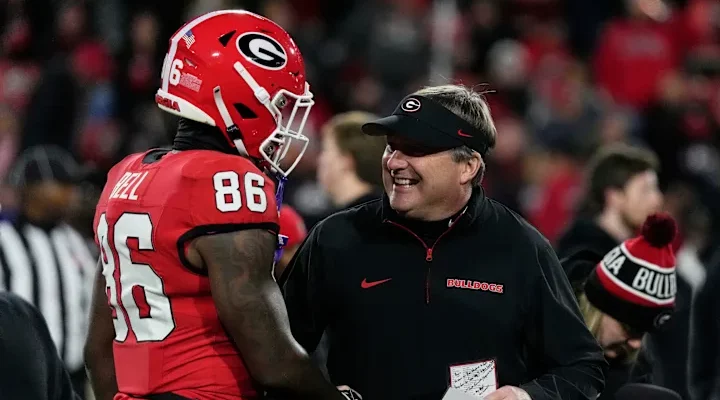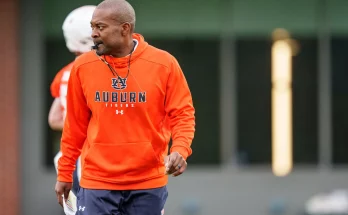Georgia’s Only Weak Spot? Bulldogs Must Sharpen This Key Stat if They Want Another Title in 2025
If there’s one thing Georgia football has gotten used to, it’s excellence. Under Kirby Smart, the Bulldogs have built a powerhouse that reloads instead of rebuilds. They’ve claimed national titles, stacked elite recruiting classes, sent players to the NFL in waves, and stayed in the national spotlight year after year. But even for the best, there’s always room for improvement. And heading into the 2025 season, there’s one key area where Georgia must tighten up if they want to get back to the top: red zone efficiency.
That’s right—of all the stats Georgia dominates in, red zone scoring, specifically touchdowns inside the 20-yard line, was not where it needed to be in 2024. Despite an explosive offense led by quarterback Carson Beck and a balanced run game, Georgia too often settled for field goals in situations that should have ended with six points. In big games, that can be the difference between controlling a game and letting it slip away.
Red zone efficiency isn’t a flashy stat. It doesn’t make headlines like total yards, sacks, or explosive plays. But ask any coach and they’ll tell you—it’s one of the most important indicators of a championship-caliber team. You can drive the field all you want, but if you can’t finish, you’re leaving points on the table. And in a league as competitive as the SEC, where every possession matters and most games come down to a handful of plays, that’s a risk Georgia can’t afford to keep taking.
In 2024, Georgia moved the ball consistently against nearly every defense they faced. Beck was efficient, smart, and rarely turned the ball over. The offensive line was one of the best in the country. The Bulldogs had reliable weapons at receiver, tight end, and out of the backfield. But when the field shrank and defenses packed the box inside the red zone, Georgia sometimes lacked that killer instinct. Drives that should’ve been touchdowns stalled out. Third downs came up short. Play-calling got a bit conservative. And instead of putting teams away, Georgia kept some opponents in games longer than they should’ve been.
That’s not to say Georgia was bad in the red zone—they weren’t. They were still above average by national standards. But that’s not the bar in Athens. When the goal is a national title, “above average” isn’t good enough. You need to be elite in every phase. And while the Bulldogs were dominant on defense, outstanding in the trenches, and precise in the passing game, their red zone numbers lagged behind their other metrics. That’s the one piece of the puzzle they’ll need to fix this fall.
So how does that improvement happen? First, it starts with mindset. Red zone offense is about confidence and aggression. It’s about knowing that when you’re inside the 20, the expectation isn’t three points—it’s seven. That has to be the standard every time. Georgia has the talent to do it. Beck is back for another year with more experience. The run game is deep and physical, featuring multiple backs who can thrive in tight spaces. And perhaps most importantly, the offensive staff knows this is a point of emphasis. Head coach Kirby Smart isn’t one to ignore data. When something needs fixing, he fixes it. Expect Georgia to put a real focus on red zone execution this summer and into the fall.
Another factor is play design. Inside the red zone, defenses get more compact. There’s less room to stretch vertically, so creative route combinations and misdirection become even more important. Georgia has done a good job using tight ends in these areas in the past, especially with players like Brock Bowers. But with Bowers off to the NFL, others will need to step up. Look for Oscar Delp to take on a bigger role here. He’s got size, good hands, and a natural feel for space. Using him in short-yardage play-action or seam routes could open things up and give Beck a reliable red zone target.
Wide receivers will also be key. In 2024, Georgia saw flashes from guys like Dominic Lovett and Rara Thomas, but didn’t always get consistent separation near the goal line. That needs to change. This season, a healthy Arian Smith and a confident Dillon Bell could be game-changers in this area. Smith’s speed forces safeties to respect the deep ball, even in short spaces, which can clear lanes underneath. Bell is physical and sure-handed, making him a prime option on slants and quick outs. Add in rising talent from the freshman class, and Georgia has the bodies—they just need the execution.
Then there’s the run game, which has always been a staple of Georgia football. But last year, there were times when the Bulldogs couldn’t punch it in from inside the five. Whether it was hesitation in the backfield or missed blocks on the edge, those short-yardage failures were costly. This season, Georgia is expecting Branson Robinson to return to full strength. If he’s healthy, he provides that downhill punch that turns 2nd-and-goal from the three into a touchdown instead of a chip-shot field goal. He’s a physical runner who finishes his runs, and his presence alone changes how defenses stack the box.
Don’t overlook the offensive line either. Georgia’s o-line was solid last year, but they weren’t always dominant in short-yardage. The coaching staff knows that and has made interior line strength a priority. Moving bodies at the point of attack is essential in the red zone. That’s where games are won. If Georgia’s line can take a step forward in that area, everything else becomes easier. You can run it up the gut, give your QB more time, and dictate the flow of the game instead of reacting to it.
Coaching adjustments will play a part, too. Offensive coordinator Mike Bobo is in his second year of this stint, and the comfort level with Beck should allow for more aggressive play-calling. That matters. Sometimes, the difference between a field goal and a touchdown is one bold call—a QB draw on 3rd-and-5, a jump pass from a tight end, or a screen that catches the defense flat-footed. Those are the kinds of plays that show trust in your players and catch defenses off guard. Bobo will have to open the playbook a bit more in the red zone, especially in high-pressure games.
Red zone improvement might not sound like the sexiest offseason narrative, but it’s arguably the most important for a team like Georgia. Every other area of their program is operating at a high level. They have depth, leadership, experience, and a championship pedigree. But fixing the red zone isn’t just about scoring more points. It’s about sending a message. It’s about finishing drives with authority and leaving no doubt. It’s about taking momentum from your opponent and never giving it back.
And here’s the scary part—for the rest of college football at least. If Georgia does improve in the red zone, there may be no stopping them. Their defense is still elite. Their quarterback is seasoned and efficient. Their offensive line is mean. If they can add ruthless red zone execution to that mix, they become almost impossible to beat. That’s the kind of team that doesn’t just win championships—they dominate them.
So don’t expect Kirby Smart to ignore this issue. He knows the margin for error at the top is razor-thin. The College Football Playoff isn’t getting easier. The SEC is only getting tougher. The target on Georgia’s back is bigger than ever. If they want to run the table and reclaim the national title in 2025, they’ll need to be better when it counts most—inside the 20-yard line.
Watch it closely this season. When Georgia marches down the field, pay attention to what happens next. Are they settling? Or are they finishing? Because that single difference might be the one thing standing between another playoff run and another championship parade.



